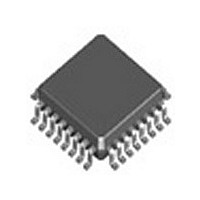DJLXT384LE.B1SE001 Intel, DJLXT384LE.B1SE001 Datasheet - Page 49

DJLXT384LE.B1SE001
Manufacturer Part Number
DJLXT384LE.B1SE001
Description
Manufacturer
Intel
Datasheet
1.DJLXT384LE.B1SE001.pdf
(140 pages)
Specifications of DJLXT384LE.B1SE001
Screening Level
Industrial
Mounting
Surface Mount
Operating Temperature (min)
-40C
Operating Temperature (max)
85C
Lead Free Status / RoHS Status
Not Compliant
- Current page: 49 of 140
- Download datasheet (2Mb)
6.3.3
6.3.3.1
6.3.3.2
Document Number: 248994
Revision Number: 005
Revision Date: November 28, 2005
Receiver Loss-Of-Signal Detector
The LXT384 Transceiver loss-of-signal (LOS) detector circuit is designed to detect loss of signals
in both analog and digital domains. This circuit is independent of the data slicer.
The receiver monitor loads a digital counter at the RCLK frequency. The counter is incremented
each time a zero is received, and reset to zero each time a one (mark) is received. Depending on the
operation mode, a certain number of consecutive zeros sets the LOS signal. The recovered clock is
replaced by MCLK at the RCLK output with a minimum amount of phase errors. MCLK is
required for receive operation. When the LOS condition is cleared, the LOS flag is reset and
another transition replaces MCLK with the recovered clock at RCLK. RPOS/RNEG will reflect the
data content at the receiver input during the entire LOS detection period for that channel.
G.755 and ETSI 300 233 - Loss of Signal Detection
ANSI T1.231 - Loss of Signal Detection
The T1.231 LOS detection criteria is employed. LOS is detected if the signal is below 200 mV for
175 contiguous pulse positions. The LOS condition is terminated upon detecting an average pulse
density of 12.5% over a period of 175 contiguous pulse positions starting with the receipt of a
pulse. The incoming signal is considered to have transitions when the signal level is equal or
greater than 250 mV.
5. The data slicer processes the received signal, after which the signal simultaneously goes to
•
•
•
•
both the clock and data-recovery sections.
In hardware mode, it complies with the latest ITU G.775 (for E1) and ANSI T1.231 (for T1)
recommendations.
Under software control, the detector can be configured to comply to the ETSI ETS 300 233
specification (
In G.775 mode a loss of signal is detected if the signal is below 200mV (typical) for 32
consecutive pulse intervals. The LOS flag is reset when the received signal reaches 12.5%
ones density (4 marks in a sliding 32-bit period) with no more than 15 consecutive zeros and
the signal level exceeds 250mV (typical). Following the next MCLK transition, MCLK is
replaced with a recovered clock at the RCLK output.
In ETSI 300 233 mode, a loss of signal is detected if the signal is below 200mV for 2048
consecutive intervals (1 ms). The LOS condition is cleared and the output pin returns to Low
when the incoming signal has transitions when the signal level is equal or greater than 250mV
for more than 32 consecutive pulse intervals. This mode is activated by setting the LACS
register bit to one.
— The data and timing recovery circuits provide an input jitter tolerance better than required
— Depending on the options selected, recovered clock and data signals may be routed
by ITU G.823, as shown in Test Specifications,
Jitter Tolerance Performance” on page
through the jitter attenuator, through the HDB3/AMI decoder, and may be output to the
framer as either bipolar or unipolar data.
LACS
Register).
Intel
®
LXT384 Octal T1/E1/J1 S/H PCM Transceiver with JA
128.
Figure 33, “Intel® LXT384 Transceiver
49
Related parts for DJLXT384LE.B1SE001
Image
Part Number
Description
Manufacturer
Datasheet
Request
R

Part Number:
Description:
Microprocessor: Intel Celeron M Processor 320 and Ultra Low Voltage Intel Celeron M Processor at 600MHz
Manufacturer:
Intel Corporation

Part Number:
Description:
Intel 82550 Fast Ethernet Multifunction PCI/CardBus Controller
Manufacturer:
Intel Corporation
Datasheet:

Part Number:
Description:
Intel StrataFlash memory 32 Mbit. Access speed 120 ns
Manufacturer:
Intel Corporation
Datasheet:

Part Number:
Description:
Intel StrataFlash memory 32 Mbit. Access speed 120 ns
Manufacturer:
Intel Corporation
Datasheet:

Part Number:
Description:
Intel StrataFlash memory 64 Mbit. Access speed 150 ns
Manufacturer:
Intel Corporation
Datasheet:

Part Number:
Description:
Intel StrataFlash memory 32 Mbit. Access speed 100 ns
Manufacturer:
Intel Corporation
Datasheet:

Part Number:
Description:
DA28F640J5A-1505 Volt Intel StrataFlash Memory
Manufacturer:
Intel Corporation
Datasheet:

Part Number:
Description:
5 Volt Intel StrataFlash?? Memory
Manufacturer:
Intel Corporation
Datasheet:

Part Number:
Description:
5 Volt Intel StrataFlash?? Memory
Manufacturer:
Intel Corporation

Part Number:
Description:
Intel 6300ESB I/O Controller Hub
Manufacturer:
Intel Corporation
Datasheet:

Part Number:
Description:
Intel 82801DB I/O Controller Hub (ICH4), Pb-Free SLI
Manufacturer:
Intel Corporation
Datasheet:

Part Number:
Description:
Intel 82801FB I/O Controller Hub (ICH6)
Manufacturer:
Intel Corporation
Datasheet:

Part Number:
Description:
Intel Strataflash Memory28F128J3 28F640J3 28F320J3
Manufacturer:
Intel Corporation
Datasheet:











